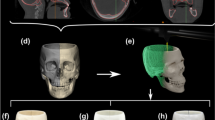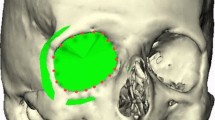Abstract
Purpose
The aim was to develop a method for reproducible orbital volume (OV) measurement in vivo based on 3D printing.
Methods
Twelve orbits were obtained from dry skulls of the Human Anatomy Department of Lille University. Computer tomography (CT) slice images of these orbits were transformed into stereo-lithography (STL) format and 3D-printed. Bone openings were closed using either putty and cellophane after printing (3D-Orb-1) or at the printing stage in silico using MeshMixer (3D-Orb-2). The results were compared with those of the conventional water-filling method as a control group (Anat-Orb).
Results
The observers reported a mean orbital volume of 21.3 ± 2.1 cm3 for the open-skull method, 21.2 ± 2.4 cm3 for the non-sealed 3D-printing method, and 22.2 ± 2.0 cm3 for the closed-print method. Furthermore, the intraclass correlation coefficients (ICCs) showed excellent intra-rater agreement, i.e., an ICC of 0.994 for the first observer and 0.998 for the second, and excellent interobserver agreement (ICC: 0.969). The control and 3D-Orb-1 groups show excellent agreement (ICC: 0.972). The 3D-Orb-2 exhibits moderate agreement (ICC: 0.855) with the control and appears to overestimate orbital volume slightly.
Conclusion
Our 3D-printing method provides a standardized and reproducible method for the measurement of orbital volume.






Similar content being viewed by others
References
Acer N, Sahin B, Ergür H, Basaloglu H, Ceri NG (2009) Stereological estimation of the orbital volume: a criterion standard study. J Craniofac Surg 20:921–925. https://doi.org/10.1097/SCS.0b013e3181a1686d
Adachi B (1904) Die orbita und die hauptmasse des schadels der Japaner. Z F Morphol Anthropol 7:379–386
Ahn HB, Ryu WY, Yoo KW, Park WC, Rho SH, Lee JH et al (2008) Prediction of enophthalmos by computer-based volume measurement of orbital fractures in a Korean population. Ophthalmic Plast Reconstr Surg 24:36–39. https://doi.org/10.1097/IOP.0b013e31815eb7ce
Berger AJ, Kahn D (2012) Growth and development of the orbit. Oral Maxillofac Surg Clin N Am 24:545–555. https://doi.org/10.1016/j.coms.2012.08.001
Bontzos G, Mazonakis M, Papadaki E, Maris TG, Blazaki S, Drakonaki EE et al (2019) Ex vivo orbital volumetry using stereology and CT imaging: a comparison with manual planimetry. Eur Radiol 29:1365–1374. https://doi.org/10.1007/s00330-018-5691-9
Charteris DG, Chan CH, Whitehouse RW, Noble JL (1993) Orbital volume measurement in the management of pure blowout fractures of the orbital floor. Br J Ophthalmol 77:100–102. https://doi.org/10.1136/bjo.77.2.100
Ching JA, Ford JM, Decker SJ (2020) Aging of the adult bony orbit. J Craniofac Surg 31:1082–1085. https://doi.org/10.1097/SCS.0000000000006311
Deveci M, Oztürk S, Sengezer M, Pabuşcu Y (2000) Measurement of orbital volume by a 3-dimensional software program: an experimental study. J Oral Maxillofac Surg 58:645–648. https://doi.org/10.1016/s0278-2391(00)90157-5
Furuta M (2001) Measurement of orbital volume by computed tomography: especially on the growth of the orbit. Jpn J Ophthalmol 45:600–606. https://doi.org/10.1016/s0021-5155(01)00419-1
Gayat T (1873) Essais de Mensuration de L’Orbite. Ann d’Ocul 70:1–10
Hatcher DC (2012) CT & CBCT imaging. Oral Maxillofac Surg Clin N Am 24:537–543. https://doi.org/10.1016/j.coms.2012.07.003
Jansen J, Schreurs R, Dubois L, Maal TJJ, Gooris PJJ, Becking AG (2016) Orbital volume analysis: validation of a semi-automatic software segmentation method. Int J Comput Assist Radiol Surg 11:11–18. https://doi.org/10.1007/s11548-015-1254-6
Khonsari RH, Adam J, Benassarou M, Bertin H, Billotet B, Bouaoud J et al (2021) In-house 3D printing: why, when, and how? Overview of the national French good practice guidelines for in-house 3D-printing in maxillo-facial surgery, stomatology, and oral surgery. J Stomatol Oral Maxillofac Surg S2468–7855(21):00162–00172. https://doi.org/10.1016/j.jormas.2021.08.002
Koppel DA, Foy RH, McCaul JA, Logan J, Hadley DM, Ayoub A (2003) The reliability of “Analyze” software in measuring orbital volume utilizing CT-derived data. J Cranio-Maxillo-Fac Surg 31:88–91. https://doi.org/10.1016/s1010-5182(02)00170-1
McGurk M, Whitehouse RW, Taylor PM, Swinson B (1992) Orbital volume measured by a low-dose CT scanning technique. Dentomaxillofac Radiol 21:70–72. https://doi.org/10.1259/dmfr.21.2.1397459
Mottini M, Wolf CA, Seyed Jafari SM, Katsoulis K, Schaller B (2017) Stereographic measurement of orbital volume, a digital reproducible evaluation method. Br J Ophthalmol 101:1431–1435. https://doi.org/10.1136/bjophthalmol-2016-309998
Nightingale CL, Shakib K (2019) Analysis of contemporary tools for the measurement of enophthalmos: a PRISMA-driven systematic review. Br j oral maxillofac surg. 57(9):904–912. https://doi.org/10.1016/j.bjoms.2019.06.026
Nicot R, Schlund M, Sentucq C, Raoul G (2019) A new orbito-zygomatic complex reconstruction technique using computer-aided design and manufacturing-assisted harvest of autologous calvarial bone in cases of orbito-zygomatic benign tumor. J Oral Maxillofac Surg 77:1082–1091. https://doi.org/10.1016/j.joms.2018.12.024
Osaki TH, de Castro DK, Yabumoto C, Mingkwansook V, Ting E, Nallasamy N et al (2013) Comparison of methodologies in volumetric orbitometry. Ophthal Plast Reconstr Surg 29:431–436. https://doi.org/10.1097/IOP.0b013e31829d028a
Osguthorpe JD (1991) Orbital wall fractures: evaluation and management. Otolaryngol Head Neck Surg 105:702–707. https://doi.org/10.1177/019459989110500511
Saiepour D, Messo E, Hedlund AJO, Nowinski DJ (2012) Radiologic and long-term clinical outcome from treatment of isolated medial orbital wall blowout fractures. J Craniofac Surg 23:1252–1255. https://doi.org/10.1097/SCS.0b013e31825e4e8e
Sarnat BG (1970) The imprint method to determine orbital volume in the rabbit. Ophthalmologica 160:142–151. https://doi.org/10.1159/000305983
Schlund M, Lutz J-C, Sentucq C, Bouet B, Ferri J, Nicot R (2020) Prediction of post-traumatic enophthalmos based on orbital volume measurements: a systematic review. J Oral Maxillofac Surg 78:2032–2041. https://doi.org/10.1016/j.joms.2020.05.049
Schultz AH (1940) The size of the orbit and of the eye in primates. Am J Phys Anthropol 26:389–408. https://doi.org/10.1002/ajpa.1330260138
Scolozzi P, Jaques B (2008) Computer-aided volume measurement of posttraumatic orbits reconstructed with AO titanium mesh plates: accuracy and reliability. Ophthal Plast Reconstr Surg 24:383–389. https://doi.org/10.1097/IOP.0b013e318185a72c
Shyu VB, Hsu CE, Chen CH, Chen CT (2015) 3D-assisted quantitative assessment of orbital volume using an open-source software platform in a Taiwanese population. PLoS ONE. https://doi.org/10.1371/journal.pone.0119589
Sentucq C, Schlund M, Bouet B, Garms M, Ferri J, Jacques T et al (2021) Overview of tools for the measurement of the orbital volume and their applications to orbital surgery. J Plast Reconstr Aesthet Surg JPRAS 74:581–591. https://doi.org/10.1016/j.bjps.2020.08.101
Sicurezza E, Palazzo G, Leonardi R (2011) Three-dimensional computerized tomographic orbital volume and aperture width evaluation: a study in patients treated with rapid maxillary expansion. Oral Surg Oral Med Oral Pathol Oral Radiol Endod 111:503–507
Sigron GR, Barba M, Chammartin F, Msallem B, Berg B-I, Thieringer FM (2021) Functional and cosmetic outcome after reconstruction of isolated, unilateral orbital floor fractures blow out fractures with and without the support of 3D-printed orbital anatomical models. J Clin Med 10:3509
Strong EB, Fuller SC, Chahal HS (2013) Computer-aided analysis of orbital volume: a novel technique. Ophthal Plast Reconstr Surg 29:1–5. https://doi.org/10.1097/IOP.0b013e31826a24ea
Acknowledgements
The authors thank Romain Derivaux for his help in the Data collection. The authors also sincerely thank those who donated their bodies to science so that anatomical research could be performed. Results from such research can potentially increase mankind’s overall knowledge that can then improve patient care. Therefore, these donors and their families deserve our highest gratitude.
Funding
Nil.
Author information
Authors and Affiliations
Contributions
All authors contributed to the study conception and design. Material preparation, data collection and analysis were performed by RN, XD, JF, and NP. The first draft of the manuscript was written by NP, manuscript editing was performed by MS and FB. Final manuscript was approved by every authors.
Corresponding author
Ethics declarations
Conflict of interest
The authors have no relevant financial or non-financial interests to disclose.
Additional information
Publisher's Note
Springer Nature remains neutral with regard to jurisdictional claims in published maps and institutional affiliations.
Rights and permissions
About this article
Cite this article
Piot, N., Barry, F., Schlund, M. et al. 3D printing for orbital volume anatomical measurement. Surg Radiol Anat 44, 991–998 (2022). https://doi.org/10.1007/s00276-022-02968-x
Received:
Accepted:
Published:
Issue Date:
DOI: https://doi.org/10.1007/s00276-022-02968-x




